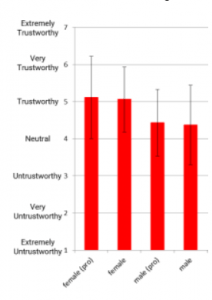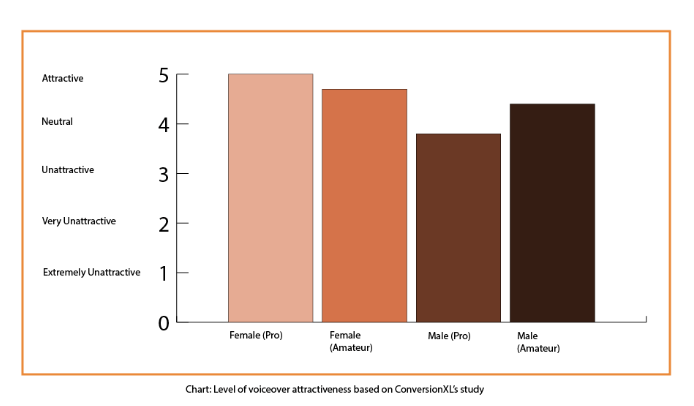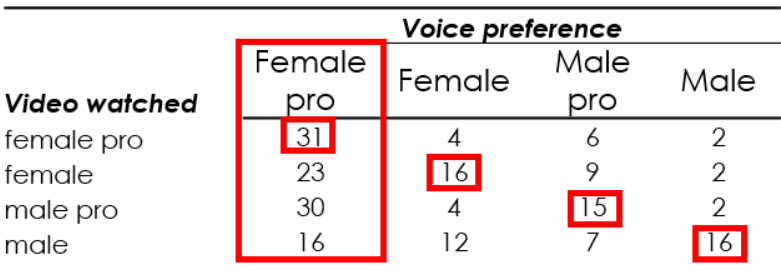
We always look for a way to make the final cut of our explainer videos stunning. The voice-over is one among several ways that can pave the way to that end result. A voice-over isn’t merely the narration that goes along with the animation in an explainer video.
A wise choice of voice actors can make a video trustworthy and attractive, while a poor choice of voice actor can degrade a well-made explainer video.
Ultimately, a decision as simple as choosing a male or female voice actor has the potential to alter the messages in an explainer video in terms of clarity, consistency, and effectiveness.
In this article, we’re going to talk about how male and female voice actors can shape how viewers perceive your explainer video.
Male or Female Voice Actor: What Does Research Say?
ConversionXL conducted research on which type of voice actor to use in one of their explainer videos.
Instead of doing the research by simply comparing male and female voice actors, they added two additional variables: professional and nonprofessional.
So four types of voice actors were tested: professional male, professional female, nonprofessional male, and nonprofessional female.
They wanted to find out how “trustworthy” and “attractive” these different voices were perceived as being.
Here’s what they learned from the research.
In terms of trustworthiness, female voices were stronger than males’ narration of the explainer video as shown in the diagram below.
The male professional was the least favorite of all four categories.
Viewers significantly prefer female voiceovers to male voiceovers.
Whether the female voice actor was professional or nonprofessional did not affect anything significantly.
In another research study featured on the VoiceBunny blog, male and female voices seemed to appeal to different demographics.
They did a head-to-head comparison between male and female voice actors to find out how each of them performed. What they found from this research follows:
- In terms of forcefulness, 48% of the respondents said that male voices sounded more forceful, while 49% of those surveyed said that sex made no difference.
- 46% of respondents said that female voices were more soothing, while 46% said sex didn’t make any difference.
- 28% of respondents felt that a male voice was “more likely to sell me a car” compared to just 7% who chose a female voice.
- 23% also said that a male voice was “more likely to sell me a computer” compared to just 7% who picked a female.
The last two findings from VoiceBunny’s research use products that are often associated with males instead of females. There’s a good chance that the result would be different if the products were lipstick and foundation.
In short, from these two research studies we can conclude that, in terms of viewers’ preferences and perceptions of likability, female voices win, but when it comes to selling for a specific demographic (e.g: car enthusiasts), male voices take the lead.
Let’s go into a deeper analysis.
Why Your Audience Prefers Female Voice-Overs: the Analysis
Before we go into the analysis, let’s get one thing out of the way:
Choosing between male and female voice-overs is not a cut-and-dry task. It can only be decided by how you want your explainer video to reach your audience and what message you are going to use.
Again, the demographic of your target market is a major factor that affects whether you should use a male or female voice-over.
Most of the time, you’ll be better off using a voice-over that corresponds to your audience’s majority gender. But female voices are generally perceived as friendlier by everyone.
Male Voice Over
A male voice-over is typically utilized for selling products that are aimed at male consumers, and a female voice-over is typically used for products aimed at female consumers.
Male voices are perceived to be more authoritative and commanding than female voices, and most of the time this is the only surefire win that male voice-overs have over female ones.
“Men’s voices are associated with neutrality, with authoritative, factual information,” explains Arthur Chu, a Cleveland-based artist who’s done voice-over work for brands like Safeway and Intel.
“The voiceover you want for some kind of authoritative instructional video, or something asserting dry historical fact, is going to be that baritone, somewhat monotone, slightly stern voice.”
If your product is related to cars, computers, or the newest gadget, then a male voice-over is a good option; that’s typically the audience interested in those products.
Female Voice Overs
Female voiceovers, on the other hand, have been known to sound more intimate and emotional than male voices, but there’s more to female voices than just that.
Higher Pitch
Female voices typically have a higher pitch than males. Psychologist Phil McAleer recorded 64 different people saying “Hello,” and the results showed that female voices were more trustworthy than male voices. High-pitched voices were seen as more trustworthy compared to low-pitched voices because high-pitched voices hint at confidence.
Comforting nature
A Harris Interactive poll found 46 percent of participants rated female voices as more soothing than male voices. Soothing voices can make people feel comfortable, and when people feel comfortable, they’re more inclined to trust.
Melodic
The melodic nature of a female voice can also play a role in the trust it instills, as can the fact that female and male voices are processed by different parts of the brain. A University of Sheffield study found female voices are processed by the auditory region of the brain, the same area that processes music. Male voices are processed in the back of the brain in an area known as the “mind’s eye.”
Emotional
“Because females tend to be the more nurturing gender by nature, their voices are often perceived as a helper, more compassionate, understanding, and non-threatening,” says Debbie Grattan, a veteran voice-over artist for brands like Apple, Samsung, and Wal-Mart.
Takeaway
Generally, there is no clear-cut answer to which gender you should use for a voice-over because the question is heavily dependent on who your target audience is and what kind of message there is to deliver.
However, data proves that generally female voices are preferred over male voices, and here’s why:
- Female voice-overs are perceived as more emotional and intimate.
- Human brains have evolved to trust high-pitched voices more than lower-pitched ones, and female voices are generally higher-pitched.
- Male voice-overs prove to be more effective for products aimed at males, whereas female voice-overs can apply to virtually any product or service.
Again, this is not to say that male voice-overs are bad for your explainer videos. They can work well if your product is somehow aimed at males.
But the ultimate takeaway is when in doubt, use female voice-overs. What are your thoughts on female vs. male voice-overs? Let me know below.



